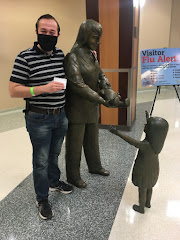The Covid-19 Pandemic has definitely affected our lives. I, along with my fellow faculty and staff colleagues at A&M-Commerce, have settled in a sedentary, virtual life where department meetings and classes are on Zoom or Microsoft Teams (it is easier to join a online meeting with a click of the mouse instead of traveling to a meeting location, yet I do miss the frequent interactions I once had with my co-workers). We no longer shake hands when we greet new people, electing to fist-bump or briefly touch elbows. Also, we are constantly pulling our masks up and over our noses as the face coverings begin to fall off when we start talking. Social distancing is the new norm, and large gatherings are a fad of the past. Simply put, life is different.
 |
| People wore masks/face coverings during the 1918 "Spanish Flu" Pandemic. |
Many say that history repeats itself. This phrase is certainly true in many ways. The world was plagued with another large-scale, deadly pandemic in 1918. Prior to the end of the Great War (now known as the First World War), an Army cook named Albert Gitchell fell ill from an unknown H1N1 influenza A virus. Since Gitchell worked at Camp Funston in Kansas, the virus quickly spread among other young cadets. After the American cadets were shipped overseas to fight in the trenches, the number of positive cases of this virus escalated to phenomenal numbers in Europe. The virus then spread to North Africa, India, Japan, and China. At the war's end in November 1918, thousands had died from the deadly virus, including youthful soldiers and home front citizens. The first and second waves of the virus caused a significant disruption in military operations during World War I; over 3/4 of French troops, 1/2 of the British military, and 900,000 German soldiers got sick from this virus. The front-line reports became so alarmingly to European governments that the politicians created World War I censors to minimize the stories of the virus and maintain positive morale. Since Spain (a neutral country during the Great War) was hit especially hard during this period, many newspapers began to label the sickness as the "Spanish Flu." After the Spanish King Alfonso XIII caught the sickness, the "Spanish Flu" name stuck. Since our scientists did not then have the modern technology to quickly develop a vaccine, preventative measures were put in place, including gauze mask wearing and public area curfews. Moreover, schools, churches, and theatres were all closed to reinforce social distancing (sounds familiar?!).
 |
| Hospital beds were quickly filled when the "Spanish Flu" Pandemic escalated in the latter-half of 1918. Red Cross nurses quickly helped their patients. |
The Red Cross set up temporary wards in auditoriums and school gyms across the country. Fort Sam Houston in San Antonio experienced a massive virus outbreak in September 1918 when the Red Cross nurses could not handle the 234 positive cases in one day. Taking precautions, City Health Officer Dr. William Anthony King asked managers of San Antonio's entertainment venues to keep their ventilation systems running that day and prevent anyone from entering their establishments who exhibited signs of the "Spanish Flu." At the start of October, city physicians reported an average of 100 positive cases a day. On October 19, San Antonio suffered its worst flu day of that year; a record of 700 influenza cases were reported during a 24-hour period. Nurses began to get sick and were swiftly replaced with student trainees. The situation worsened until preventable measures were put in places and cases decreased in number by the end of 1918. Schools and other public areas re-opened, and the San Antonio civilians got to enjoy the end-of-war festivities. Between September 1918 and January 1919, over 12,300 positive cases of the "Spanish Flu" were recorded in San Antonio, and 881 people died- a whopping 7.1% of the city's population. Historians and social scientists now predict that 100 million people perished from the "Spanish Flu" worldwide, ranking the 1918 influenza as the second most-deadliest pandemic in history (second to the infamous Black Death). Despite the heavy number of deaths and dark days of World War I and the "Spanish Flu," the human race managed to survive and thrive afterwards. Hopefully, the end of the Covid-19 Pandemic is approaching, and similar to the aftermath of its 1918 cousin, the world will be able to get back on its feet and continue to grow and prosper.
 |
| Happy to have received my second Covid-19 vaccine at the Hunt Regional Medical Center. |
I recently received my second Covid-19 dose; in spite of the chills and muscle aches I had the following day, I am grateful to be fully vaccinated. And I continue to wear my mask in all public areas and protect my family and colleagues. In other professional news, Texas Escapes Magazine recently published my article on the history of Whitley Hall, a high-rise dormitory at A&M-Commerce and the tallest structure in Northeast Texas. This is my fourth article that has been published by Texas Escapes; my others are histories on Wesley College and Burleson College (now-defunct junior colleges in Greenville), and Hell's Half Acre (Fort Worth's little-known red light district). I am incredibly grateful for the support I have received from Kate Wong Troesser, the magazine's fantastic editor/webmaster.
Link to the Whitley Hall article is below:
http://texasescapes.com/JoshuaVChanin/Whitley-Hall-TAMUCommerce-High-Rise-Dormitory.htm
 |
| I oversaw the housing operations at Whitley Hall between 2018 and 2020. Photo taken in Aug. 2019. |


No comments:
Post a Comment